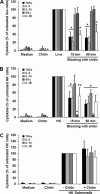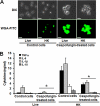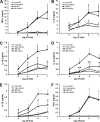Recognition and blocking of innate immunity cells by Candida albicans chitin
- PMID: 21357722
- PMCID: PMC3088140
- DOI: 10.1128/IAI.01282-10
Recognition and blocking of innate immunity cells by Candida albicans chitin
Abstract
Chitin is a skeletal cell wall polysaccharide of the inner cell wall of fungal pathogens. As yet, little about its role during fungus-host immune cell interactions is known. We show here that ultrapurified chitin from Candida albicans cell walls did not stimulate cytokine production directly but blocked the recognition of C. albicans by human peripheral blood mononuclear cells (PBMCs) and murine macrophages, leading to significant reductions in cytokine production. Chitin did not affect the induction of cytokines stimulated by bacterial cells or lipopolysaccharide (LPS), indicating that blocking was not due to steric masking of specific receptors. Toll-like receptor 2 (TLR2), TLR4, and Mincle (the macrophage-inducible C-type lectin) were not required for interactions with chitin. Dectin-1 was required for immune blocking but did not bind chitin directly. Cytokine stimulation was significantly reduced upon stimulation of PBMCs with heat-killed chitin-deficient C. albicans cells but not with live cells. Therefore, chitin is normally not exposed to cells of the innate immune system but is capable of influencing immune recognition by blocking dectin-1-mediated engagement with fungal cell walls.
Figures








Similar articles
-
Immune recognition of Candida albicans beta-glucan by dectin-1.J Infect Dis. 2007 Nov 15;196(10):1565-71. doi: 10.1086/523110. Epub 2007 Oct 31. J Infect Dis. 2007. PMID: 18008237 Free PMC article.
-
Variable recognition of Candida albicans strains by TLR4 and lectin recognition receptors.Med Mycol. 2010 Nov;48(7):897-903. doi: 10.3109/13693781003621575. Med Mycol. 2010. PMID: 20166865
-
Immune sensing of Candida albicans requires cooperative recognition of mannans and glucans by lectin and Toll-like receptors.J Clin Invest. 2006 Jun;116(6):1642-50. doi: 10.1172/JCI27114. Epub 2006 May 18. J Clin Invest. 2006. PMID: 16710478 Free PMC article.
-
TLR2, but not TLR4, triggers cytokine production by murine cells in response to Candida albicans yeasts and hyphae.Microbes Infect. 2006 Jul;8(8):2299-304. doi: 10.1016/j.micinf.2006.03.014. Epub 2006 Jun 5. Microbes Infect. 2006. PMID: 16782386 Review.
-
Recognition of non-self-polysaccharides by C-type lectin receptors dectin-1 and dectin-2.Glycobiology. 2009 Jun;19(6):568-75. doi: 10.1093/glycob/cwp032. Epub 2009 Mar 14. Glycobiology. 2009. PMID: 19287024 Free PMC article. Review.
Cited by
-
Development of an in vitro model for the multi-parametric quantification of the cellular interactions between Candida yeasts and phagocytes.PLoS One. 2012;7(3):e32621. doi: 10.1371/journal.pone.0032621. Epub 2012 Mar 30. PLoS One. 2012. PMID: 22479332 Free PMC article.
-
Endogenous thrombospondin-1 regulates leukocyte recruitment and activation and accelerates death from systemic candidiasis.PLoS One. 2012;7(11):e48775. doi: 10.1371/journal.pone.0048775. Epub 2012 Nov 7. PLoS One. 2012. PMID: 23144964 Free PMC article.
-
Silencing of OCH1 unveils the role of Sporothrix schenckii N-linked glycans during the host-fungus interaction.Infect Drug Resist. 2018 Dec 28;12:67-85. doi: 10.2147/IDR.S185037. eCollection 2019. Infect Drug Resist. 2018. PMID: 30643435 Free PMC article.
-
Disruption of protein rhamnosylation affects the Sporothrix schenckii-host interaction.Cell Surf. 2021 Jun 26;7:100058. doi: 10.1016/j.tcsw.2021.100058. eCollection 2021 Dec. Cell Surf. 2021. PMID: 34308006 Free PMC article.
-
Silencing of MNT1 and PMT2 Shows the Importance of O-Linked Glycosylation During the Sporothrix schenckii-Host Interaction.J Fungi (Basel). 2025 May 2;11(5):352. doi: 10.3390/jof11050352. J Fungi (Basel). 2025. PMID: 40422686 Free PMC article.
References
-
- Brown G. D., Gordon S. 2001. Immune recognition. A new receptor for beta-glucans. Nature 413:36–37 - PubMed
Publication types
MeSH terms
Substances
Grants and funding
LinkOut - more resources
Full Text Sources
Other Literature Sources
Medical
Molecular Biology Databases
Research Materials

